I feel neither more “good” nor more “patient”. I am a hard-headed woman, as always. Attached to life, as ever!
The day when my friend Pigi, my oncologist, told me that I had breast cancer, I cried desperately. The first thing I did was to phone my [...]]]>
I feel neither more “good” nor more “patient”. I am a hard-headed woman, as always. Attached to life, as ever!
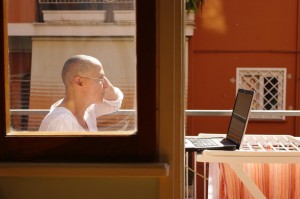
Paola Rolletta by Luis Abelard
The day when my friend Pigi, my oncologist, told me that I had breast cancer, I cried desperately. The first thing I did was to phone my partner to tell him this piece of news, of which I had had some premonition. And I understood that premonition really exists.
Curiously, I did not wonder “Why me?” My reaction was: “This cursed disease has hit me too!”
Perhaps some survival instinct made me articulate my feelings in this way, to ease the pain in my heart.
There are more and more of us, women between 40 and 50 years of age, diagnosed with cancer, most of hormonal origin. I must read more about the disease: until now, I have not allowed myself such reading.
First I said that I couldn’t read more about cancer until I finished this calvary of chemotherapy. Now that I finished the eight sessions, I say that I will wait to read until I have the CAT (computer axial tomography) results.
In a nutshell, I don’t want to cram on cancer because I decided to trust my three doctors, the surgeon, the oncologist and the nutritionist, to save me from this darkness.
In darkness
What shocked me most is the darkness you live through while undergoing chemotherapy. It is almost like a mirror lysergic acid experience, but instead of colourful hallucinations, they are black, like anti-matter.
Maybe it is the chemicals shot into my body during six months (eight chemo sessions, 4 FEC and 4 Docetaxel, every 21 days) that makes me see the world, inside and outside, so dark.
The darkness weighs more heavily than the hair loss, the nausea and the vomiting. This metaphysical darkness that totally grabs you is devastating: no words, gestures, musical notes or flowers. For a long time, darkness dominated my thoughts and my soul – an unnatural darkness that does not spring from disease-associated pessimism.
To find strength, I tell myself that mine is a chemical pessimism that – I hope, I trust – will save my life.
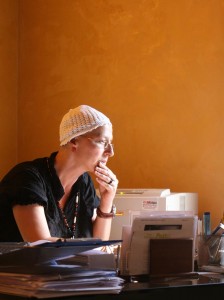
Photo: Sol de Carvalho
And I hope that radiotherapy next month will be less dark!
Feeding nitro-glycerine to my body
Earlier this year, I wanted to quit smoking and went to the naturopath for acupuncture. In her office by the sea in Maputo, Dr. Fernanda examined me and told me, without mincing words, to have a mammogram right away. Because I smoked and took birth control pills for decades, I was literally feeding a cancer with all that poison, that nitro-glycerine, she said. Just like this. Raw and cruel.
I was so frightened I took the first flight back to my home country, Italy. That saved my life! Dr. Fernanda was right, in her cruel way. Even when I did not have any symptoms, even though I had not felt any lump, she was right.
Cancer is a multi-factor disease but breast cancer is, most cases, of hormonal origin. Why these hormones go crazy and make us develop cancer it is not known yet, but that they are to blame, this is known. This knowledge is a great leap forward to cure many cancer patients and to prevent the disease.
Ten years ago I read “Illness as a Metaphor” by Susan Sontag while I was working on a documentary on AIDS in Uganda for Portuguese TV.
Ten years later, I re-read it. I tracked it down in the boxes where I stored my books when I moved to Maputo.
In the meantime, Susan Sontag died of cancer. I remember her, wearing a green dress, in a photo taken by her lover Annie Leibovitz.
Every day I repeat to myself Sontag’s call to realism: cancer can be treated with chemotherapy more efficiently than with diets or psychotherapy. Sontag unpacked beliefs that have fed the popular mythology about cancer up to these days.
Every day I repeat her words in the introduction: illness is the night-side of life, a more onerous citizenship.
The disease that has hit me contains, paradoxically, an element of reassurance: every day I must face a new day, a daily routine. Suffering serves as a mediator between my will to live and all that is threateningly unknown. But the unknown is part of life itself. It is life.
]]>Center for the Study of AIDS, University of Pretoria, South Africa
Fabrications is the theme of the 2010 calendar produced by the Center for the Study of AIDS. The gorgeous images are digitally manipulated African textiles.
The notion of “fabrications” was inspired by the many [...]]]>
Center for the Study of AIDS, University of Pretoria, South Africa
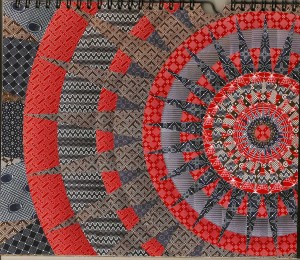 Fabrications is the theme of the 2010 calendar produced by the Center for the Study of AIDS. The gorgeous images are digitally manipulated African textiles.
Fabrications is the theme of the 2010 calendar produced by the Center for the Study of AIDS. The gorgeous images are digitally manipulated African textiles.
The notion of “fabrications” was inspired by the many stories of the AIDS quilts – designed to tell a story about someone who had died of AIDS, to honour them and to create a memorial to them that could be used as part of the fabric of people’s daily lives.
A fabrication is in this sense both a physical construction of fabrics, but also a psychological and social construction, the story of a life.
We need to tell people’s stories but we also need to acknowledge that we use stories to make sense of AIDS, to cope with it, to fashion it into something bearable, to give it meaning.
Story telling is a universal art form, but has a special significance for Africa. This calendar looks at different African fabrics, each telling a story about its creator and its country. The calendar offers ways to take these designs to tell new stories and produce new “fabrications”. 
Many of the AIDS quilt stories had elements of “fabrication”, in that they were a blend of truth, memory and fantasy. It is the fantasy and fiction that is just as fascinating as “the truth”.
In the same way as people mythologized the dead, we as societies deal with HIV and AIDS by creating myths and fabrications of the epidemic, to cope with and make sense of it.
There are the myths of virgin protection, the myths of HIV in oranges, the myths of worms in condoms, of deliberate infection through syringes, and many other myths that are part of the fabric of dealing with HIV and AIDS.
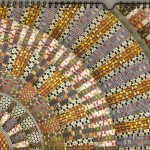 But there are other fabrications and fantasies as well – that routine testing is a prevention strategy and can bring about universal treatment, that male circumcision is the new silver bullet, that communities can easily absorb orphans, that sexuality and identity are simply and easily understood and manipulated, that behaviour change is as simple as ABC.
But there are other fabrications and fantasies as well – that routine testing is a prevention strategy and can bring about universal treatment, that male circumcision is the new silver bullet, that communities can easily absorb orphans, that sexuality and identity are simply and easily understood and manipulated, that behaviour change is as simple as ABC.
In its work the CSA strives to challenge many of these fabrications, find ways to create new representations of the epidemic, to tell new stories, to deconstruct and reconstruct society.
At the end of this calendar are instructions on how to make a quilt, your own fabrication.
]]>In Paris, the Chilean researcher, novelist and feminist Ana (Nicha) Vazquez Bronfman had died, aged 71. She was a beacon for a generation of Latin American women for her insights on identity and gender. One [...]]]>
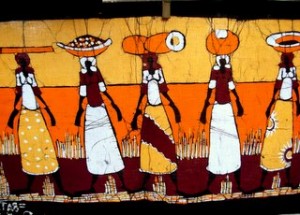
Motherhood, sisterhood, friendship.
In Paris, the Chilean researcher, novelist and feminist Ana (Nicha) Vazquez Bronfman had died, aged 71. She was a beacon for a generation of Latin American women for her insights on identity and gender. One concept she elaborated specially was “transculturation” – the permanent construction of identities in this world of global migration. In 2006 she wrote superbly about sexuality among the elderly – transgressions and secrets, she called it.
In Rome, my friend and fellow journalist Paola Rolletta underwent the next to last chemotherapy session against breast cancer. She was jubilant to see the end of the chemical bombardment. Like antiretrovirals, chemo saves lives but is no picnic.
So, in three hours, youth, disease, health and death touched me. Motherhood and friendship. Joy and sorrow.
Email has made this vertigo possible. News travel quickly and straight to our screens, to our hearts and minds.
News from friends
These days, breast cancer appears more frequently in news from friends.
One in the Dominican Republic and another in Mozambique finished their chemo last year. Paola is finishing hers in February. In Pretoria, where I live, another friend had her second chemo last Friday.
We had lunch together today and wondered if there is more breast cancer among women now than 50 years ago, or better detection. If the rates are higher, why? Lifestyle, fast food, stress, radiation from microwaves, cellphones and all the gadgets that crowd our life?
The Harvard School of Public Health estimates that the poor will account for more than 55 percent of breast cancer deaths this year. Read a very informative story on growing cancer rates among women in the developing world here.
A recent article in the New England Journal of Medicine argues that “western” influences such as changes in diet, less exercise, delayed childbirth, families with fewer children, less breast feeding, and hormone replacement therapy are all thought to increase the risk of breast cancer for women in low-income countries.
The good news is that breast cancer, like AIDS, is becoming less and less lethal, if detected and treated early.
I am so proud of my cancer-survivor friends. They have worn their baldness as a badge of courage and have acquired new wisdom.
And while we age and think about breast cancer, a younger generation moves closer to adulthood.
I wondered how to name and save this rambling text in my laptop. And I wrote – BLOG: LIFE.
]]>At the coffee plantation Monte Café, to the left of its dilapidated pink colonial buildings, stands a huge shed. The caretaker unlocks a gigantic padlock and we step into a surreal [...]]]>
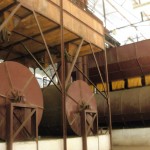
Ghost factory. By M. Sayagues
At the coffee plantation Monte Café, to the left of its dilapidated pink colonial buildings, stands a huge shed. The caretaker unlocks a gigantic padlock and we step into a surreal décor for a tropical Blade Runner movie.
The shed houses a web of pipes and drums, coffee-processing machinery made by the Brazilian company Pinhalense. It is huge, complex – and never used.
The caretaker remembers when the machines were put in place, about a decade ago, but he never saw them working.
Donors pulled the plug on this US$24 million project after US$14 were spent and a few siphoned off.
The project was sponsored by ESAGRI, the agricultural arm of the Portuguese group Espirito Santo, with US$10.9 from the African Development Bank, totalling US$13 in foreign aid.
I went with a coffee grower who groaned at all the inappropriate elements: for example, a wasteful layout and excessive drying capacity for the production of the 1,800-hectares plantation. The optical scanner for bean selection made him laugh: it required a dust-free, air-conditioned environment, not the dust, humidity and power cuts of Sao Tome.
Going back to the capital after 4 pm, there were no taxis so I start walking. A man in a 4×4 offers me a ride. He is a businessman in his fifties and he insists on showing me his failed textile factory.
In the 1980s, it produced trousers and shirts for both the local market and for Angola, following an agreement between the two allied Marxist governments. When Angola liberalized its economy in the late 1990s, the contract was cancelled and the factory closed.
“Naively, we thought the contract would go on forever and did not look for other markets,” he explained.
Another padlock, another eerily silent space, a 2,000 sq.metres building with rows of old sewing machines.
Two ghost factories: one, the failure of a donor-funded development project. The other, a failure of the post-colonial regime’s industrialisation drive.
Provocative analysis
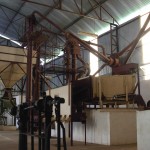
Improductive from Day One. By M. Sayagues
Africa is littered with abandoned industrial parks and two new, thought-provoking books explain why.
In Dead Aid, Zambian economist Dambisa Moyo argues that foreign aid to Africa has discouraged free enterprise while fuelling corruption and rent-seeking, defined as the use of governmental authority to make and take money without trade or production of wealth.
Aid, she says, lowers the incentive for investment and chokes off growth.
Because aid flows are seen as permanent income, policymakers have no incentive to look for other ways of financing development. Worse, they have no sense of urgency “in remedying Africa’s critical woes.”
In Architects of Poverty, South African author Moeletsi Mbeki argues that African elites obstruct the development of an indigenous entrepreneurial class, seen as a threat to their power. (Read an interview here).
Instead, elites entrench themselves as a “parasitic bureaucratic bourgeoisie…unproductive but wealthy black crony capitalists” who live off state revenues, ignore or exploit peasants, and divert profits to elite consumption or capital flight.
Mbeki notes that one of the biggest scandals is the underinvestment in transport in Africa.
Long wait
The 70 kms drive from Sao Tome to Porto Alegre on the south of the island takes 5 hours and a sturdy car to negotiate potholes.
Few minibuses ply this route because drivers don’t want to destroy their cars. So the trip from Porto Alegre to the capital turns into a day-long journey. That hurts tourism, trade and travel.
Since 7 am, Alice Tavares waited for a bus with her 2 young children and a neighbour’s teenager. They carried school satchels, two baskets of fish, five bundles of clothes and two jerry cans of petrol.
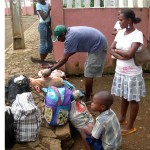
Patient Alice buys a pig. M. Sayagues
The early minibus was full. The second arrived at noon and went half-way to Angolares, where we waited for three hours. Alice bought a freshly butchered pig and stuffed it in a plastic bag. I took photos. We got to the capital after sunset.
How hard can it be to maintain a total of 320 kms of roads in the tiny islands? Since 2007, small billboards brag about a European Union aid project to improve roads. What a joke. Looks more like dead aid managed by the architects of poverty.
]]>I just attended the Grassroots Women’s International Academy on Home Based Care in Johannesburg, South Africa.
It was a mixed bag of fun meeting women from all walks and works of life from Kenya, Cameroon, Uganda, Malawi, Nigeria, Ethiopia, Rwanda, Zambia, [...]]]>
I just attended the Grassroots Women’s International Academy on Home Based Care in Johannesburg, South Africa.
It was a mixed bag of fun meeting women from all walks and works of life from Kenya, Cameroon, Uganda, Malawi, Nigeria, Ethiopia, Rwanda, Zambia, Ghana, Namibia, Zimbabwe, and South Africa.
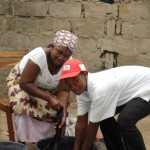
Caregiving in Mozambique. Photo: Janine Morna
The Huairou Commission and the Land Access Movement of South Africa brought us together to share experiences of home-based care.
It is fascinating how in Malawi the care givers alliance has moved forward. Victoria Kalomba, of the Malawi Group of Women Living with HIV and AIDS told us that the ministry of health and social development had spearheaded a campaign to raise awareness about people infected and affected by HIV.
The process had the ministry informing the support groups of individuals who had tested positive after visiting clinics so they could be reached and helped.
I am worried about this way of outing positive people even in the aim of mobilizing support groups. I feel that it is a human right violation to have to give information of someone’s HIV status.
Victoria was less worried. She said that the government has passed a policy that makes any name calling of people living with HIV a criminal offence. Okay.
Yet there is always stigma, just like one hears sexist and racist comments daily. Just because it is punishable has not stopped people from abusing or victimizing others. So I am wary of this and rather uncomfortable.
Next move
For caregivers, the issues are:
· remuneration,
· training and recognition of care givers as professionals,
· logistic and material support,
· psycho-social support to care givers and
· gender equality, and encouraging men to participate in care giving
Our next move is to lobby governments to recognize care work as a profession.
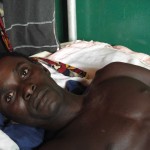
Carers ease the burden of disease. Photo: M. Sayagues
My sense is that there is a need for an alliance to assist in forming one body to represent caregivers. Most women caregivers said they felt disrespected, as they are not recognised for all their care work in health. No thanks are coming their way. They are very sore and disheartened at this lack of recognition. To move forwards, they require a voice to represent them.
One caregiver from Ethiopia said: “I will be taking so much home! I have realised that there are other countries struggling with lack of government support in the area of care work. We hope to continue to be in touch, especially on the issue of the alliance”.
To be able to laugh, as we share these issues, gives one hope. It is a strategy that I feel will take these unsung heroes to greater heights and at some point their voices will be heard.
As we said farewell, I felt a strong bond of sharing experiences and a need to continue the network.
I am sure I will meet most of these passionate women at this week’s SADC Heads of State Summit in Kinshasa, Democratic Republic of Congo, where today GEMSA is launching its report “Making Care Work Count – A Policy Analysis.”
The study covers Botswana, Democratic Republic of Congo, Lesotho, Malawi, Mauritius, Mozambique, Namibia, South Africa, Swaziland, Tanzania, Zambia and Zimbabwe.
GEMSA will strategize with civil society partners to lobby around care work in these countries.
]]>“It smells strongly of wine gone vinegary but it works ,” he says.
Last year, [...]]]>
“It smells strongly of wine gone vinegary but it works ,” he says.
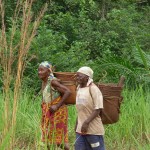
The forest is their pharmacy. Photo: M. Sayagues
Last year, when he was scratching madly with chickenpox, his granny’s ointment of coconut oil and leaves relieved the itchiness.
When his friend Geane Castro feels a cold coming, his grandmother makes him a hot bath with water infused with leaves and bark, then a special tea with plants she gathers in the forest. Presto, he recovers.
I meet them at Teia D’Arte, an art gallery in Sao Tome, the capital of the tiny two-island nation of Sao Tome and Principe, off the coast of Gabon.
With a rich biodiversity of 600 botanical species and 132 endemic plants, the islands’ rainforest is a well-stocked pharmacy for herbalists.
Their knowledge is captured in a decade-long ethno-pharmacological study published last year. Researchers worked with 40 traditional healers, midwives and grandmothers to identify and classify 325 medicinal plants, note 1,000 recipes and test 25 plants in the lab. Many look promising for developing new medicines.
Generations of expertise
Across Africa, healers hold an impressive knowledge of medicinal plants, accumulated through generations and transmitted through years of apprenticeship.
The new generation of healers blends tradition with modernity. They throw the bones, brew herbal medicines, book patients by cellphone and negotiate the complexities of modern life. They follow tradition and break away from it.
Nkunzi Zandile Nkabinde is a young Zulu sangoma – the word for traditional healer in South Africa.  She works in Soweto, married her partner in June, and wrote a book about her life in an homophobic society: Black Bull, Ancestors and Me: My Life as a Lesbian Sangoma.
She works in Soweto, married her partner in June, and wrote a book about her life in an homophobic society: Black Bull, Ancestors and Me: My Life as a Lesbian Sangoma.
Today, 31 August, is the African Traditional Medicine Day, established in 2001 by the World Health Organisation.
Repressed by colonial authorities, condemned as witchcraft by churches, spurned by post-colonial Marxist governments, African traditional medicine is regaining prestige.
The WHO describes it as “heritage, knowledge and healing that is affordable, accessible, and culturally acceptable”.
For a majority of Africans, especially rural, traditional medicine is the main professional health care, sometimes the only one available,or the cheapest and closest. In the cities, many people will consult both a bio-medical doctor and a traditional healer.
In Africa, to cure is to restore human vitality and harmony with the universe. Body and soul are not separate entities; they are linked to nature, spirits and other people.
The timeless wisdom of healers is an essential part of African health. “It would be sad to lose this knowledge,” says Sousa.
]]>So what headlines have grabbed you lately about male circumcision in South Africa? These caught my eye:
“The death toll in the Eastern Cape’s winter circumcision season has risen to 31”
“Circumcision ‘scam’ probed”
“Two [...]]]>
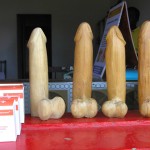
Hard task: defining sexual pleasure. Photo: M. Sayagues
So what headlines have grabbed you lately about male circumcision in South Africa? These caught my eye:
“The death toll in the Eastern Cape’s winter circumcision season has risen to 31”
“Circumcision ‘scam’ probed”
“Two on run after initiate dies”
As alarming and distressing as these headlines are – and the sad, desperate and greedy subtexts embedded in them – they don’t say much about the other big debate that is raging across southern Africa: the value of male circumcision to prevent HIV acquisition in heterosexual men, and what’s in it for women.
Well what’s in it for women is the topic du jour: Since observational studies had reported an association between male circumcision and reduced risk of HIV infection in female sexual partners, researchers in Uganda conducted an unblinded, randomised control trial to investigate this (Lancet July 2009) by circumcising some HIV positive men and not others. They found that circumcision did not reduce the risk of transmission to their female partners. So no luck there.
But what’s really getting gender activists of all genders to rise up from their sofas and comment on websites and chat rooms is the matter of sexual pleasure, and more specifically, the sexual pleasure of women.
What is sexual pleasure?
Now as a gay man I have to confess this is a topic that I have no personal experience of, but I am as interested in the notion of pleasure for my sisters of any sexual orientation as I am in mine.
I believe sexual pleasure should be a human right advanced to all, though for some of us this may be a progressive realisation of rights as we work through all the baggage of our socialisation!
I’m raising this issue because one of the many studies emerging as a companion to the now famous three circumcision trials, which showed the partial protective efficacy of male circumcision, suggests that “women whose male sexual partners were circumcised report an improvement in their sex life.”
Nearly 40% said sex was more satisfying afterward. About 57% reported no change in sexual satisfaction, and only 3% said sex was less satisfying after their partner was circumcised.
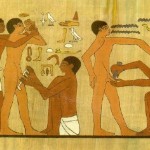
Ancient Egyptians get the snip.
Top reasons cited by women for their better sex life: improved hygiene, longer time for their partner to achieve orgasm, and their partner wanting more frequent sex, said Godfrey Kigozi at the Fifth International AIDS Society Conference on Pathogenesis, Treatment and Prevention of HIV in Cape Town recently.
Firstly, if you look at the data above, while 40% did say the sex was more satisfying, the majority in fact said there was either no change or it was less satisfying. Is the headline summary of the research accurate? Why do we need to spin this data?
Fluid and enigmatic
But really what’s vexed me, and others, is this notion of pleasure and how we define it. Those of us who come from a “social” as opposed to “biomedical” or “public health” paradigm would argue that sexuality is fluid, it changes over our lifetimes, it may be context or relationship dependent, it is informed not only by our gender but our class and orientation.
So “pleasure” in a sexual encounter may be shaped by mood, the time of life, the way a woman is relating to her partner that day, whether she was exhausted from chores, her beliefs about female agency in a sexual encounter, whether she was menstruating or in menopause, whether foreplay had occurred.
Pleasure, surely, is variable, contextual, dynamic, changing, unpredictable. Even enigmatic sometimes: a woman may have a good orgasm but still feel angry with her husband or partner. She may never have had an orgasm but feel happy that he does. She may secretly masturbate after he falls asleep and feel fantastic after that.
A biomedical or public health perspective, I would argue, reduces men and women and their practice to simple categories and distinct binaries: gay vs straight; masculine vs feminine; satisfied vs unsatisfied; safe vs dangerous.
This is necessary if you want a simplified view of the world and if you want “proof” that most women will be happy to have their male partners circumcised.
Who needs long and complicated qualitative research when a checklist with a choice of three options tells us all we need to know to placate those pesky social scientists with their doubts and ifs, buts and maybes? But how do you capture the nuances of satisfaction in a questionnaire?
You don’t. I think pleasure is much more complicated than that – and we need better and more interesting research to tease it out (as it were). What do you think?
Read more on controversial issues around male circumcision, sexual pleasure, human rights, viagra and condoms.
]]>